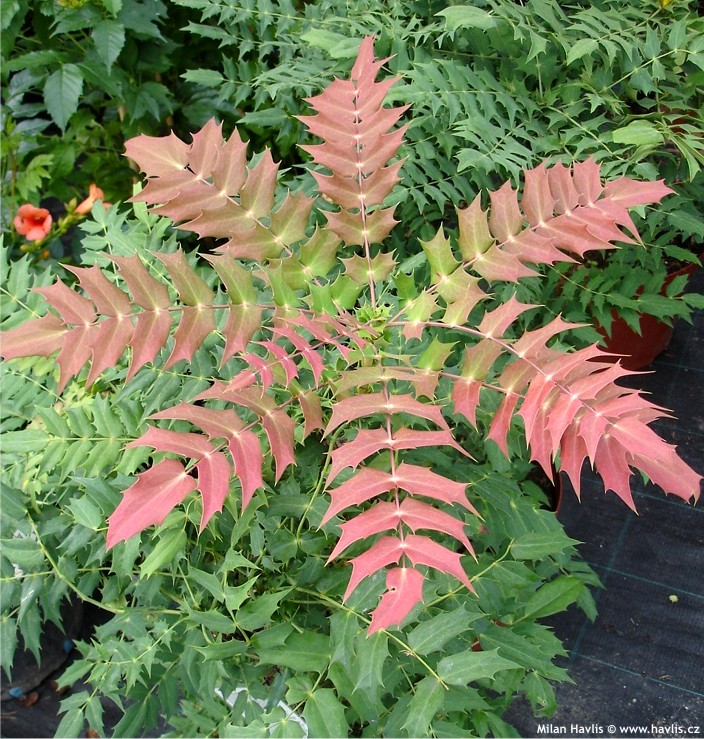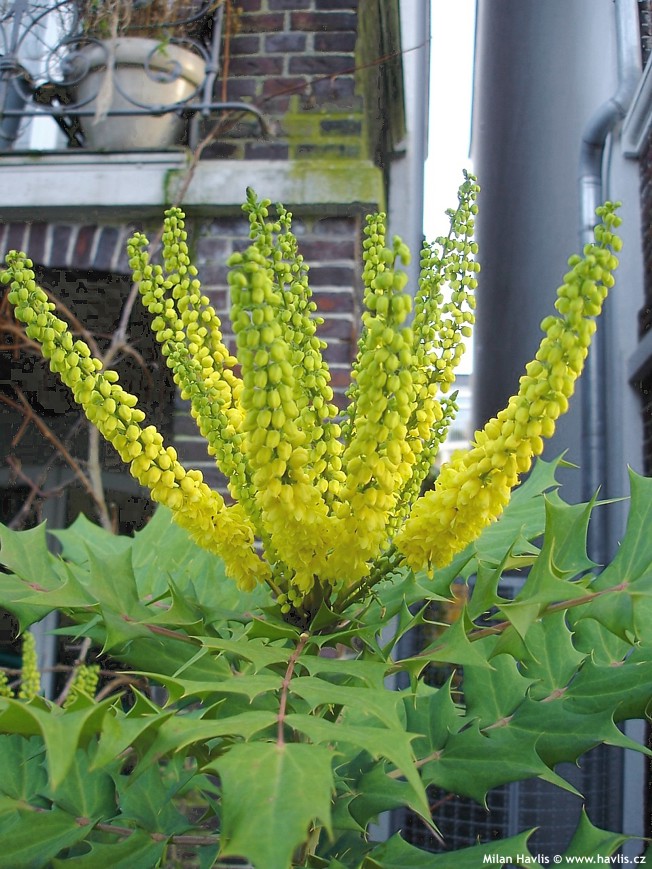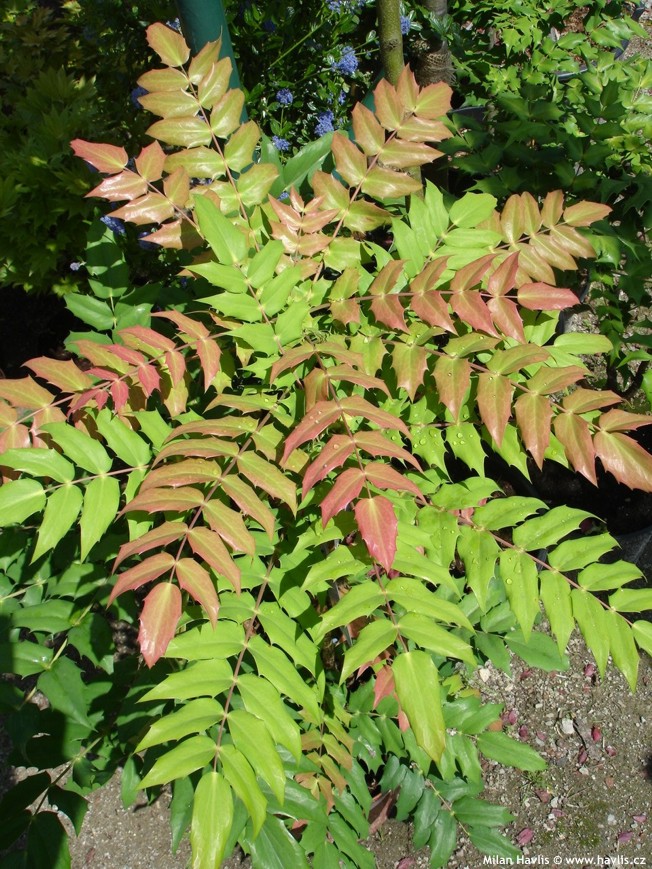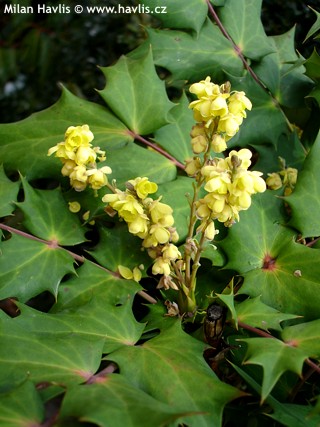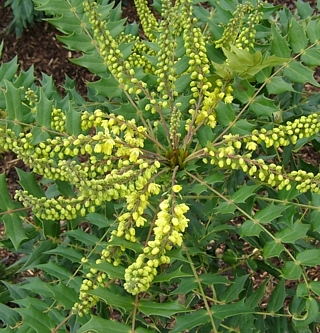Mahonia x media 'WINTER SUN' hybrid Oregon grape, grape holly
size/type
medium-sized shrub,taller shrub
usual height
1,5-2,5m
usual width
1-1,5m
leaves
evergreen broadleaf
colour of leaves
flowers
showy
colour of flowers
blooming time
December-March
location
semi-shade to shade
soil type
acidic (peaty) to neutral
soil moisture requirements
evenly moist (dislikes drought)
USDA zone (lowest)
8 (down to -18°C)
winter protection
for zone 5+6

for zone 7

categorized
Mahonia
Hybrid Oregon grape arose from the accidental cross-pollination between Japanese M. bealei and Chinese M. lomariifolia at the Slieve Donard Nursery Company in Northern Ireland in the years 1950-1951. This spontaneous hybridization was later discovered by Sir Eric Savill, director of the royal estate's forests at Windsor Great Parks in England, who selected several seeds for cultivation in Savill Gardens. When these seedlings began to bloom in 1957, it became clear that they were different from the parent plants. The first, more robust with longer flowers, was named 'Charity', and the second, more compact and with shorter but upright flowers, was named 'Winter Sun'. The genus name Mahonia was chosen in honour of the significant American horticulturist of Irish descent, Bernard McMahon (1775-1816).Description of the plant:
Winter Sun is the second variety of Hybrid Oregon grape. It was selected at the Slieve Donard Nursery Company and introduced in 1966. Its leaves are evergreen, leathery, pinnately compound, consisting of 15 to 21 stiff, glossy leaflets of deep green colour with typically 5 inconspicuous, prickly spines. Their shape resembles a giant fern, and the whole leaf measures 30-34 cm in length. Young plants, in poor soils and containers, may lose chlorophyll in the autumn (it retreats to the roots), displaying beautiful scarlet and burgundy tones during the cold months before the sap rises again in spring. Young leaves are handsome, too, as they emerge in a rare pastel salmon tone.These types of Mahonia are valued for their winter flowering, which is exceptional in Central European landscape. From late autumn, they form slender and upright terminal racemes about 20 cm long with buds that gradually open from the inside of the bush outwards. They bloom over a very long period from December to February or March, even when the temperature is around zero or a few degrees centigrade below zero at night, and if the frost is stronger, they simply wait for warmer days. The individual flowers are bright sulphur yellow and pleasantly fragrant on warm, wind-free days of winter. And I am telling you that an evergreen shrub in full bloom right in the middle of winter looks like from outer space 😊.
Mahonia belongs to the Berberidaceae family, and like most of its representatives, this hybrid mahonia, too, produces a large number of fruits after flowering, unless they are damaged during unusually severe February frosts. They are small, elongated, dark blue berries with a greyish sheen similar to blueberries. They are edible, slightly on the acid side, and quite tasty raw, but due to the quantity of seeds, you won't yield much pulp.
It naturally forms multi-stemmed shrubs with fleshy and somewhat fragile, upright branches that have a striking yellow colour on the cross-section. Its aim is to grow as high as possible, often lacking side branches in the lower parts that would thicken the bush. Sometimes this is intentionally utilized along with removing leaves from the bottom to enhance its exotic multi-stemmed appearance, which can evoke a palm tree image due to its large and evergreen leaves at the top. If, on the other hand, you desire a bushy and dense plant from the ground up, don't be afraid to cut the long canes in half after flowering. They will reliably regenerate.
Mahonia x media i a perfect shrub for semi-shade and shade, which can tolerate the competition of the roots of large surrounding trees because it has a shallow root system. On the other hand, this may make it more susceptible to drying out, so adjust its moisture by year-round mulching and frequent control for watering, especially at the end of summer, when it starts to produce flower buds. It prefers humus-rich, acidic to neutral soil without lime content. Its superpower is its tolerance to exhaust fumes and smog, which is why it is often planted in the greenery of large cities. There it also benefits from the accumulated heat, which helps it bloom in winter. The flower buds withstand temperatures around -18 °C (USDA zone 7), and at lower temperatures, depending on the duration of the severe frost, the upper leaves may burn, or the upper parts of the branches can die off and will need to be trimmed after winter. However, frost has never damaged our entire plants even at -24 °C (USDA zone 6).
Last update 12-11-2008; 26-01-2025
QUICK PRICE OVERVIEW
CURRENTLY SOLD OUT













